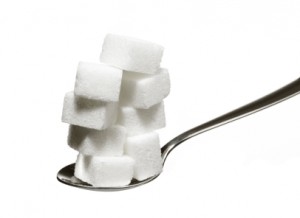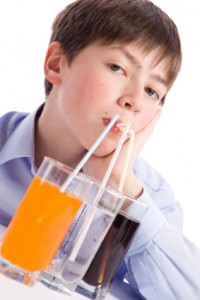New USDA Rules Restrict Sugary Drinks and Snacks
 Say goodbye to sugary snacks and drinks between classes! This is the last semester before USDA rules will restrict snack sales during school hours in public schools across the country. These include traditional junk food like chips and sodas, as well as more subtle sugar-containing beverages, like Powerade and Gatorade. Some states, such as California, had already banned these drinks in a piece of legislation that would have kicked in this fall. The USDA ruling sets tight nutrition standards for over 100,000 schools and childcare facilities in every state.
Say goodbye to sugary snacks and drinks between classes! This is the last semester before USDA rules will restrict snack sales during school hours in public schools across the country. These include traditional junk food like chips and sodas, as well as more subtle sugar-containing beverages, like Powerade and Gatorade. Some states, such as California, had already banned these drinks in a piece of legislation that would have kicked in this fall. The USDA ruling sets tight nutrition standards for over 100,000 schools and childcare facilities in every state.
However, the USDA didn’t decide how drink and snack sales should be regulated after the bell. The agency also left the states free to decide rules on bake sales and other food fundraisers, even during school hours.
That means that discussions about drinks like Gatorade, Powerade, and other sugary electrolyte drinks will continue at the state and local level. No matter your opinion of particular soda bans, container size rules, and sugar “sin taxes,” it’s important for booster clubs to be aware of the current issues facing schools and sports drinks. Any additional changes in vending rules could affect booster club fundraising, athletic programs, and student health inside and outside of the school day.
Are Sports Drinks Good for Students?
 Sports drinks are good for student athletes, for a few reasons. They replenish electrolytes and hydrate athletes (there’s a lot of water in there too!). Athletes with a normal metabolism will use up the energy in the drinks if they’re doing serious exercise, burning the sugar and calories. When you think about it, that’s actually a pretty narrow criteria for proper use of those drinks. It basically excludes elementary and grade-school kids. That’s the conclusion of a New York Times post by Gretchen Reynolds. She quotes a number of experts, like sports dietitian Nancy Clark.
Sports drinks are good for student athletes, for a few reasons. They replenish electrolytes and hydrate athletes (there’s a lot of water in there too!). Athletes with a normal metabolism will use up the energy in the drinks if they’re doing serious exercise, burning the sugar and calories. When you think about it, that’s actually a pretty narrow criteria for proper use of those drinks. It basically excludes elementary and grade-school kids. That’s the conclusion of a New York Times post by Gretchen Reynolds. She quotes a number of experts, like sports dietitian Nancy Clark.
“Most kids younger than 10 or 12 don’t work out hard enough,” said Clark. “These are not health foods.”
However, a 2005 study cited in Reynold’s article found that flavored water and sports drinks are psychologically good for young athletes’ hydration. That’s because left to their own devices, younger kids don’t drink enough water when they exercise. They simply forget to sip. But, if you give them something more enticing like a sports drink, they’ll do a better job of keeping themselves hydrated. The study found that kids consumed almost twice as much liquid than when they were only offered water. The study didn’t say what happens when you offer kids heavily watered-down Gatorade. Maybe that’s worth a try.
For non-athletes, sports drinks don’t bolster health. In fact, for the couch potato, there’s very little difference between a sports drink and a soda, at least when you look at the nutrition facts. Without intense exercise, there are no electrolytes to replace. So there’s little benefit to the body. Worse, the bad stuff that doesn’t get burned off from exercise. That seems to be the main argument behind the sports drink ban in California schools, before the USDA issued it’s rule.
“We’re trying to get at over-consumption by students who are not as physically active,” said Alex Padilla, a state senator advocating the bill on the floor. “We’re not touching the football team, we’re not touching the soccer team,” he said.
What are The Financial Benefits of Sodas and Sports Drinks?
Schools and booster clubs can raise money through drink sales. They can sell drinks directly during lunches or at games. Schools can negotiate lucrative vending contracts with local beverage distributors. A 2008 study on the economic impact of beverages contracts in schools found the following:
- Yearly payouts from beverage companies averaged $18 per student
- The average school district raised about $98,000
The studies called that “a modest amount of funding,” and it’s just a fraction of the average school budget. However, it’s a passive income stream with no fundraisers to organize and no investment. These two factors are very attractive to school administrators. Often, drink sales are also tied to drink advertising, on scoreboards, another form of passive income. Even as the USDA phases in restrictions on selling drinks during school hours, schools might participate in sales directly by vending after hours and indirectly through advertising.
For booster clubs, The USDA’s fundraiser exemption may or may not have an affect. The nutrition rules don’t apply to “Infrequent school-sponsored fundraisers (other than fundraising through vending machines, school stores, snack bars, à la carte sales […]).” Basically, snack shacks are prohibited until after class, unless they start selling healthy options. However, volunteers can sell any snacks after school, depending on what local and state regulations allow.
Under USDA federal rules, it seems like club leaders could, hypothetically, invest in a vending machine near a sports venue on a school campus, as long as it’s turned off when class is in session. Now that students have limited drink options during the school day, the demand might shift to after-hours sales. Depending on how booster clubs structure their funding model, they may try to take advantage of that uptick.
What are the Financial Drawbacks of Vending & Selling Drinks?
 However, critics are quick to point out the hidden costs of selling beverages. That same 2008 study points out that schools keep a much smaller percentage of drink sales (about 33%), than other fundraising sales (around 45% on average). Districts who negotiate hard and play companies against each other might get a better deal (the Center for Disease Control has an interesting publication about negotiating these contracts). Additionally, booster clubs might sell on higher margins than schools, but it will cost them in volunteer time.
However, critics are quick to point out the hidden costs of selling beverages. That same 2008 study points out that schools keep a much smaller percentage of drink sales (about 33%), than other fundraising sales (around 45% on average). Districts who negotiate hard and play companies against each other might get a better deal (the Center for Disease Control has an interesting publication about negotiating these contracts). Additionally, booster clubs might sell on higher margins than schools, but it will cost them in volunteer time.
One externality, cleanup cost, eats away at those already slim margins. Unlike water, drinks such as Gatorade and Coke cause a serious mess when they spill. The liquid dries up and leaves the sticky sucrose behind, along with whatever artificial coloring it held. With thousands of drink sales per year, the average gym or school hallway can expect hours in sticky beverage cleanup cost. Booster clubs usually don’t pay for cleaning, so if they sell drinks in a school facility they might not take this expense into account. However, schools do factor in that cost. One Wisconsin school district denied a booster club’s request to sell sports drinks and sodas.
“We don’t want to deal with the cost,”said school board member Bill Wipperfurth, in an interview with the Lodi Enterprise. “When you spill them they are sticky and a challenge to clean and after all is said and done, we were not interested.”
Find Out About Beverage Contracts and Rules in Your School District
Even though the USDA’s new nutrition rules will affect all schools evenly during the school day, rules across districts still vary. Some schools might remove vending machines all together and cancel or not renew their beverage agreements. Others may keep vending machine contracts and simply turn the machines on after the last bell. It’s a good time to have an informed discussion with your booster club about how drinks and snacks should play into your fundraising strategy and how they fit into your mission.
Want to know the details of beverage contracts in your school district? All you have to do is write the superintendent. For a quick response, you might want to reference local Freedom Of Information Act laws, which vary from state to state.
Did you like this post? Please share it on Facebook and Twitter. You can also post the link in your next newsletter… just sayin!




This post is generating a lot of discussion in the “Sports Parents Network” group on LinkedIn.